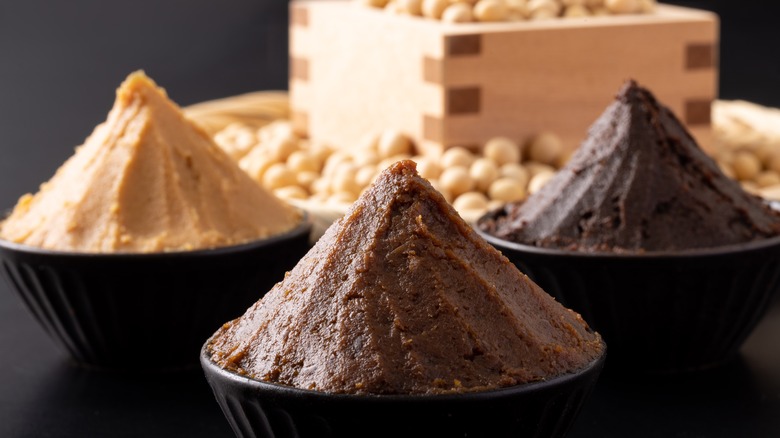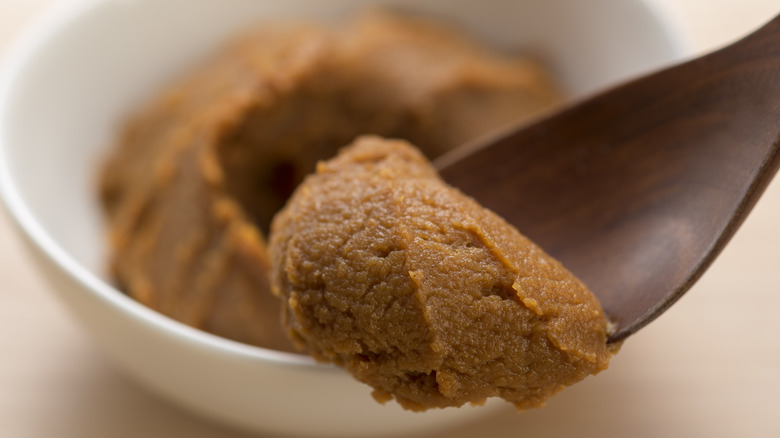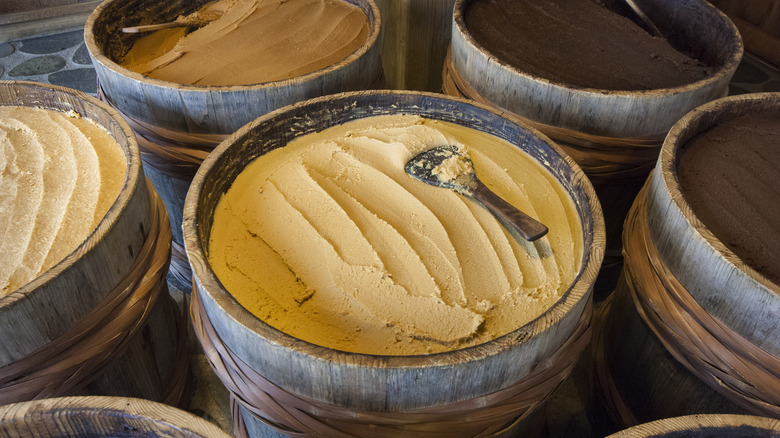Spending A Little More On Miso Goes A Long Way
There are two reasons why it's okay to pay more for high-quality miso. Foremost, good miso just tastes so much better. When it comes to first-rate miso paste, there's simply no comparing the full-bodied flavor of traditional naturally fermented miso to the mass-produced quick-made versions that sacrifice character in favor of speed and lower prices. The next reason to shell out more for top-notch miso is its health benefits, which cheaper varieties may be lacking in or devoid of entirely. When leveling up your miso, there are ways to ensure you'll get the most out of it.
Enjoyed by royalty and samurai as early as the 7th century, miso was only available to elite members of Japanese society who could afford the expensive delicacy. It wasn't until around the 15th century, when farmers mastered the art of fermentation, that miso became a food source for ordinary people. Now an essential ingredient in Japanese cuisine as well as on fusion menus far beyond the country's shores, this versatile seasoning is useful for so much more than just boring miso soup. And yet, while you no longer need to be an emperor to afford it, it's still not cheap.
Let's explore what makes great miso cost more, how its production affects its price and nutritional value, and why it's worth spending more for it. There's no shame in paying a miso premium once you know how to get the most out of that tub of salty, umami goodness.
It's alive! Why high-quality miso costs more
Miso's healing and preventative attributes are significant, and this does factor into its cost. According to a 2022 study published by Food Science & Nutrition, miso is a medicinal food effective against a wide range of conditions. Thanks to the moldy magic of fermentation, miso is teeming with probiotics that keep the gut happy. Its high protein levels and abundance of vitamins, minerals, and essential amino acids are just some of the credentials that make miso a staple of holistic macrobiotic diets, and a nourishing ingredient in many meals.
Like all fermented foods, miso is quite literally alive with beneficial microorganisms. These good bacteria cannot survive the pasteurization process used in making inferior miso, which is why it's best to opt for it raw (nama in Japanese), allowing the microbes within to flourish. Unpasteurized miso takes longer to produce and involves greater quality-control, adding to the price. For the purest miso, seek out organic brands made from non-GMO soy that isn't laden with chemical additives, but this too will bump up the price.
You can offset the expense while getting the most out of spendy miso by simply not using too much of it. Most recipes only require a small amount as the saltiness can overwhelm other ingredients. Furthermore, due to miso's elevated levels of sodium, consuming it in moderation makes sense, and will help that jar last longer.
Stick with tradition to pick the best miso
Traditional methods of making miso result in the highest-quality product. Time-tested techniques have been refined over centuries in over 1,000 varieties of miso, each with its own regional nuances. Old school miso making is labor intensive; from the long fermentation time (months to years) to the physical work involved. This YouTube video about the town of Okazaki, Japan shows the massive wooden miso vats where the pungent soybean brew gets weighed down by literally three tons of rocks — and even the rock placement is an art form that requires 10 years of training to learn. Short of getting it direct from Japan, artisanal miso can often be found locally at farmers markets.
Another way to maximize your stake in the miso game is to avoid overprocessed varieties. Superior miso has few ingredients and no added flavorings or preservatives. Quick miso may cost less, but it's often diluted with water.
It's also best to add miso at the end of cooking. The same high heat that kills off beneficial bacteria in pasteurization comes into play on your stovetop. Another pro tip is to make sure you're buying the right miso for the dish you're making. White miso has the mildest, sweetest flavor, yellow miso is more robust, and red miso has the most intense, savory profile. In choosing the appropriate and best quality miso for your cooking, the investment in fine miso will go that much further, so go ahead and splurge.



